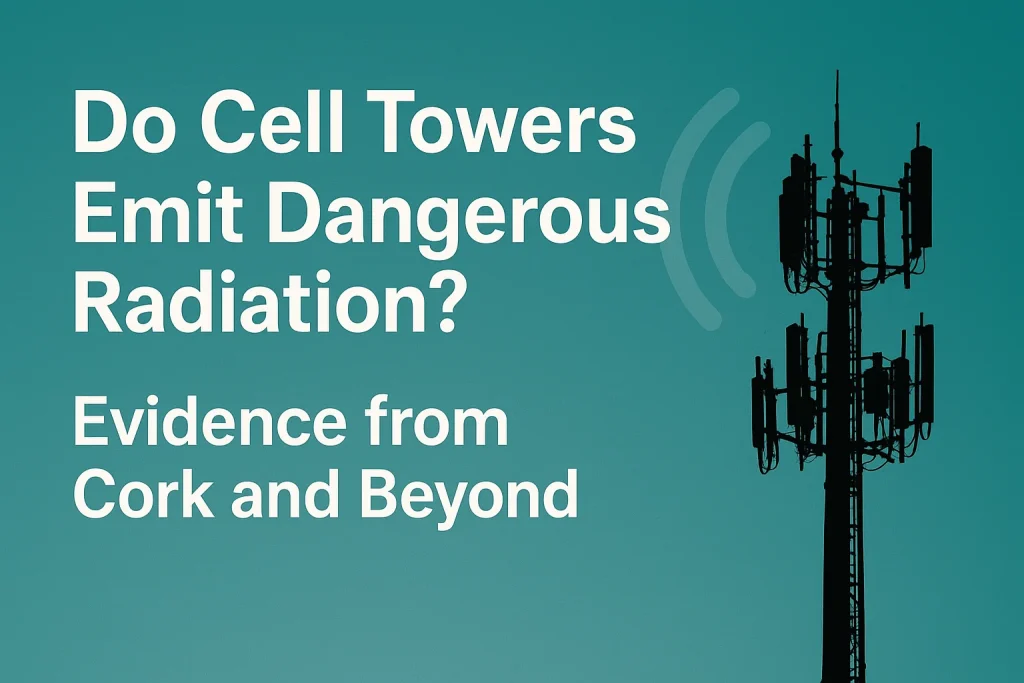Walk through any city, town, or village in Ireland today, and you’re likely to spot several tall, slender masts standing against the skyline. These are cell towers—vital infrastructure that keeps our phones connected, our data streaming, and our modern lives running smoothly. But as mobile networks expand and 5G becomes widespread, a question increasingly asked in communities like Cork is: Do cell towers emit dangerous radiation?
The topic has sparked local debate, public meetings, and online discussions. Some residents worry about potential health effects, while others trust existing safety regulations and scientific studies. To separate fear from fact, it’s worth looking closely at what science says, what evidence comes from Cork itself, and how these findings fit within global research.
Understanding What Cell Towers Emit
Before diving into the risks, it’s important to understand what kind of radiation cell towers emit. These structures send and receive radiofrequency (RF) electromagnetic waves, which are a type of non-ionizing radiation.
Non-ionizing radiation differs from ionizing radiation (like X-rays or gamma rays) because it doesn’t have enough energy to alter DNA or directly damage human cells. This distinction is critical: while ionizing radiation is proven to cause health issues at high doses, non-ionizing radiation—such as that from Wi-Fi, Bluetooth, or cell towers—has much weaker energy levels.
In Ireland, all mobile phone base stations, including those across Cork, must comply with exposure limits set by the International Commission on Non-Ionizing Radiation Protection (ICNIRP). These limits are designed with wide safety margins to protect everyone, including vulnerable populations like children and the elderly.
How Much Radiation Do Cell Towers Actually Emit?
Cell towers operate at frequencies ranging between 700 MHz and 3,500 MHz (depending on whether the signal is 4G or 5G). At these frequencies, the power density—the amount of energy transmitted—is relatively low.
To put it in perspective, standing directly beneath a cell tower typically exposes a person to RF levels thousands of times below international safety limits. This is because the antennas are directional: they beam signals horizontally across wide areas, not down toward the ground.
In Cork, environmental and telecommunications authorities periodically test radiation levels. According to the Commission for Communications Regulation (ComReg), RF measurements in Irish cities consistently remain well below safety thresholds. In many urban and suburban areas, exposure levels are less than 1% of the ICNIRP guideline limits.
This evidence supports what many independent studies have found worldwide—namely, that radiation from cell towers is minimal compared to the exposure we receive from everyday wireless devices like mobile phones.
Scientific Research: Global Findings and Local Relevance
1. International Health Agencies’ Position
Globally, numerous organizations have studied cell tower emissions and their potential health effects. The World Health Organization (WHO), Health Protection Surveillance Centre (HPSC) of Ireland, and the European Commission’s Scientific Committee on Emerging and Newly Identified Health Risks (SCENIHR) all conclude that current evidence does not show adverse health effects from low-level RF exposure below recommended limits.
The WHO continues to monitor research closely but emphasizes that no causal link has been established between cell tower exposure and health problems like cancer, infertility, or neurological disorders.
2. Independent Studies in Europe
In Europe, large-scale studies—such as those conducted in Germany, Switzerland, and the UK—have examined populations living near cell towers. Across these studies, no consistent evidence has emerged to suggest that proximity to a cell tower increases the risk of health issues.
3. The Irish Context: Evidence from Cork
Turning to local findings, Cork City and County have been part of several radiation monitoring initiatives over the past decade. Environmental engineers and independent consultants have measured RF emissions near schools, residential neighborhoods, and business districts.
The results? Across Cork, measured radiation levels consistently fall within internationally accepted safe zones—often at a fraction of the allowable limits. These findings form an important part of understanding cell phone tower radiation effects Cork residents have raised concerns about.
While public awareness campaigns and community monitoring continue, the data so far provide strong reassurance that radiation exposure from local cell towers remains extremely low.
The Fear Factor: Why People Still Worry
Despite overwhelming scientific consensus, concern about cell tower radiation persists. Why? Several psychological and societal factors are in play:
- Invisible and complex threat: Radiation cannot be seen, smelled, or felt. This invisibility naturally triggers unease.
- Rapid technological change: Each new generation of mobile technology (3G, 4G, 5G) arrives faster than the public can fully understand it.
- Mixed media messages: While scientific studies tend to be nuanced, online content can amplify fear through misleading headlines.
- Health anxiety: When people already experience symptoms like headaches or fatigue, it’s easy to attribute them to nearby towers—especially if they recently noticed one being built.
These concerns deserve empathy, not dismissal. Open communication between telecommunications companies, government bodies, and communities helps address legitimate questions while dispelling myths.
What About 5G? A New Frontier of Concern
The rollout of 5G networks brought a new wave of apprehension. Many feared that the higher frequencies used for 5G (up to 3.6 GHz in Ireland) would result in stronger or more harmful radiation.
However, the physics of RF energy tell a different story. 5G signals are actually less penetrating than lower-frequency 4G signals. Moreover, 5G infrastructure often uses small cell technology, which operates at much lower power levels and covers shorter distances.
Extensive research conducted by bodies such as the European Union’s Scientific Committee on Health, Environmental and Emerging Risks (SCHEER) confirms that 5G’s exposure levels are comparable to, or lower than, those from existing networks. So far, there is no credible evidence linking 5G to adverse health effects.
Community Monitoring and Transparency in Cork
Public trust often hinges on transparency. Recognizing this, Ireland’s ComReg runs an RF field measurement program that allows the public to access data on radiation levels at specific locations.
Residents in Cork can visit ComReg’s website and view measurement results for various cell sites. The data is displayed clearly, showing that most readings are significantly below health-based reference levels.
Community organizations have also stepped in to independently measure the cell phone tower radiation effects Cork neighborhoods experience, using portable RF monitors. The outcome of these community efforts has consistently echoed official findings: exposure remains well within safe margins.
This combination of official testing and community oversight fosters greater trust and allows residents to make informed decisions.
Practical Tips for Concerned Residents
Even though radiation levels from cell towers are considered safe, people who remain concerned can take simple steps for peace of mind:
- Check local data: Use ComReg’s database to view exposure levels near your home or workplace.
- Consult health authorities: For scientifically sound advice, refer to WHO and HPSC resources on electromagnetic fields (EMFs).
- Engage in dialogue: If a new tower is proposed nearby, attend community consultations to express your views and hear expert explanations.
- Focus on higher exposures: Paradoxically, the phone you hold to your ear emits far more RF energy than a tower hundreds of meters away. Using speaker mode or a headset significantly reduces personal exposure.
Environmental Considerations
Apart from human health, some Cork residents have expressed concern about the possible effects of RF radiation on wildlife, especially birds and bees. While laboratory studies occasionally show behavioral changes in insects exposed to strong RF fields, these are typically conducted at power levels far above what exists near cell towers.
Field research in Ireland and other European countries has not demonstrated measurable ecological harm at environmental exposure levels. Still, continued ecological monitoring remains essential as technology evolves.
Balancing Connectivity and Safety
It’s easy to forget how much modern society depends on reliable mobile networks. From emergency services to online education, from business operations to personal communication—cell towers are the invisible backbone of our digital lives.
In Cork, as across Ireland, improving coverage means expanding network infrastructure. Each tower installed undergoes rigorous safety assessments before operation. The balance between connectivity and public health is maintained through strict adherence to international standards.
When communities, scientists, and regulators work together, this balance ensures both technological progress and public reassurance.
The Future of Research and Policy
Science never stands still. Continuous studies are being conducted to explore potential long-term and cumulative effects of RF exposure. Ireland’s national health authorities participate in European collaborative research to ensure that policies remain evidence-based.
Emerging technologies such as low-power Internet of Things (IoT) networks may further reduce overall radiation levels, as smaller, energy-efficient transmitters replace older, high-power systems. Cork’s growing reputation as a smart city means it could lead the way in adopting safer, greener, and more efficient communication technologies.
Conclusion:-
After decades of research, thousands of studies, and real-world monitoring in cities like Cork, the verdict remains consistent: cell towers do not emit dangerous radiation at the levels the public is exposed to.
The data gathered locally and globally paints the same picture—cell tower radiation is not a health hazard when safety standards are respected. Cork’s own environmental measurements reaffirm this finding, showing RF exposure far below established safety limits.
While it’s natural to question emerging technologies, the scientific consensus provides reassurance that cell phone tower radiation cork residents are exposed daily poses a proven health risk.
Maintaining open dialogue, community monitoring, and adherence to international guidelines will continue to ensure both safety and connectivity—helping Cork thrive in an ever-more connected world.
Frequently Asked Questions:-
1. Are cell towers in Cork emitting harmful radiation?
- No. Studies conducted in Cork and across Ireland show that radiation levels from cell towers are thousands of times lower than international safety limits. The Commission for Communications Regulation (ComReg) regularly tests these sites, and results consistently confirm that cell phone tower radiation effects Cork residents experience are well within safe exposure limits.
2. What kind of radiation do cell towers produce?
- Cell towers emit radiofrequency (RF) electromagnetic radiation, which is a type of non-ionizing radiation. This means it does not have enough energy to damage DNA or cells, unlike X-rays or gamma rays. Non-ionizing radiation from cell towers is considered safe at the levels used for mobile communication.
3. Is 5G more dangerous than previous mobile networks?
- No, 5G technology is not more dangerous than 4G or 3G. In fact, 5G operates at lower power levels and transmits signals over shorter distances. International health organizations, including the World Health Organization (WHO) and the European Commission, have found no evidence that 5G exposure within safety guidelines causes harm to human health.
4. How can Cork residents check radiation levels near their homes?
- Cork residents can easily check official radiation readings through the ComReg RF Field Measurement Programme, available online. The site lists verified data from locations across Ireland, showing that RF exposure levels remain significantly below recommended health limits. This transparency allows communities to stay informed about cell phone tower radiation effects that Cork neighborhoods may experience.
5. What is the scientific consensus on cell phone tower radiation in Ireland?
- The overall scientific consensus is clear: cell tower radiation does not pose a health risk when it remains below internationally recognized limits. Irish and global studies have shown that exposure from cell towers—including cell phone tower radiation cork residents encounter—is far lower than the thresholds known to cause biological harm.


